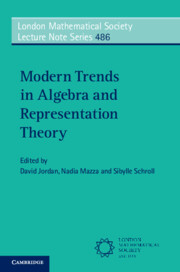Book contents
- Frontmatter
- Contents
- Contributors
- Preface
- Introduction
- 1 Auslander–Reiten Theory of Finite-Dimensional Algebras
- 2 τ-tilting Theory – an Introduction
- 3 From Frieze Patterns to Cluster Categories
- 4 Infinite-dimensional Representations of Algebras
- 5 The Springer Correspondence
- 6 An Introduction to Diagrammatic Soergel Bimodules
- 7 A Companion to Quantum Groups
- 8 Infinite-dimensional Lie Algebras and Their Multivariable Generalizations
- 9 An Introduction to Crowns in Finite Groups
- 10 An Introduction to Totally Disconnected Locally Compact Groups and Their Finiteness Conditions
- 11 Locally Analytic Representations of p-adic Groups
- References
9 - An Introduction to Crowns in Finite Groups
Published online by Cambridge University Press: 25 November 2023
- Frontmatter
- Contents
- Contributors
- Preface
- Introduction
- 1 Auslander–Reiten Theory of Finite-Dimensional Algebras
- 2 τ-tilting Theory – an Introduction
- 3 From Frieze Patterns to Cluster Categories
- 4 Infinite-dimensional Representations of Algebras
- 5 The Springer Correspondence
- 6 An Introduction to Diagrammatic Soergel Bimodules
- 7 A Companion to Quantum Groups
- 8 Infinite-dimensional Lie Algebras and Their Multivariable Generalizations
- 9 An Introduction to Crowns in Finite Groups
- 10 An Introduction to Totally Disconnected Locally Compact Groups and Their Finiteness Conditions
- 11 Locally Analytic Representations of p-adic Groups
- References
Summary
We describe the generalization of the theory of crowns in finite soluble groups to the universe of all finite groups. We also include an application of this theory to determining the minimal generator number of an arbitrary finite group.
Keywords
Information
- Type
- Chapter
- Information
- Modern Trends in Algebra and Representation Theory , pp. 317 - 334Publisher: Cambridge University PressPrint publication year: 2023
